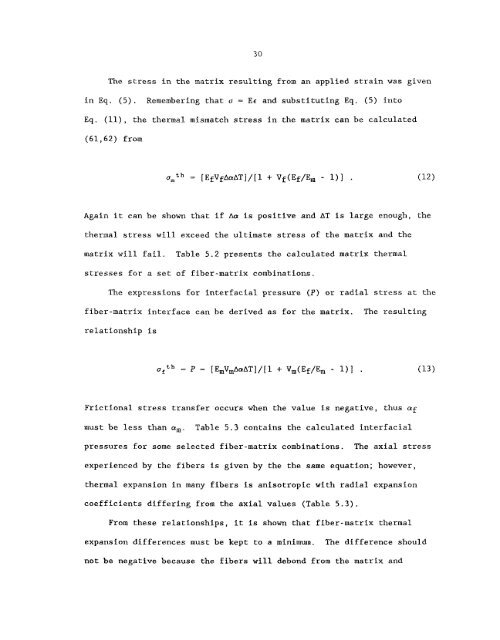Characterization and control of the fiber-matrix interface in ceramic ...
Characterization and control of the fiber-matrix interface in ceramic ...
Characterization and control of the fiber-matrix interface in ceramic ...
You also want an ePaper? Increase the reach of your titles
YUMPU automatically turns print PDFs into web optimized ePapers that Google loves.
30<br />
The stress <strong>in</strong> <strong>the</strong> <strong>matrix</strong> result<strong>in</strong>g from an applied stra<strong>in</strong> was given<br />
<strong>in</strong> Eq. (5).<br />
Remember<strong>in</strong>g that u = Ee <strong>and</strong> substitut<strong>in</strong>g Eq. (5) <strong>in</strong>to<br />
Eq. (ll), <strong>the</strong> <strong>the</strong>rmal mismatch stress <strong>in</strong> <strong>the</strong> <strong>matrix</strong> can be calculated<br />
(61,62) from<br />
Aga<strong>in</strong> it can be shown that if ha is positive <strong>and</strong> AT is large enough, <strong>the</strong><br />
<strong>the</strong>rmal stress will exceed <strong>the</strong> ultimate stress <strong>of</strong> <strong>the</strong> <strong>matrix</strong> <strong>and</strong> <strong>the</strong><br />
<strong>matrix</strong> will fail. Table 5.2 presents <strong>the</strong> calculated <strong>matrix</strong> <strong>the</strong>rmal<br />
stresses for a set <strong>of</strong> <strong>fiber</strong>-<strong>matrix</strong> comb<strong>in</strong>ations.<br />
The expressions for <strong>in</strong>terfacial pressure (P) or radial stress at <strong>the</strong><br />
<strong>fiber</strong>-<strong>matrix</strong> <strong><strong>in</strong>terface</strong> can be derived as for <strong>the</strong> <strong>matrix</strong>. The result<strong>in</strong>g<br />
relationship is<br />
Fricti-onal stress transfer occurs when <strong>the</strong> value is negative, thus af<br />
must be less than am.<br />
Table 5.3 conta<strong>in</strong>s <strong>the</strong> calculated <strong>in</strong>terfacial<br />
pressures for some selected <strong>fiber</strong>-<strong>matrix</strong> comb<strong>in</strong>ations. The axial stress<br />
experienced by <strong>the</strong> <strong>fiber</strong>s is given by <strong>the</strong> <strong>the</strong> same equation; however,<br />
<strong>the</strong>rmal expansion <strong>in</strong> many <strong>fiber</strong>s is anisotropic with radial expansion<br />
coeffici.ents differ<strong>in</strong>g from <strong>the</strong> axial values (Table 5.3).<br />
From <strong>the</strong>se relationships, it is shown that <strong>fiber</strong>-<strong>matrix</strong> <strong>the</strong>rmal<br />
expansion differences must be kept to a m<strong>in</strong>imum. The difference should<br />
not be negative because <strong>the</strong> <strong>fiber</strong>s will debond from <strong>the</strong> <strong>matrix</strong> <strong>and</strong>

















